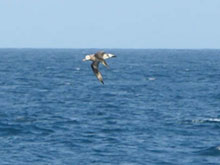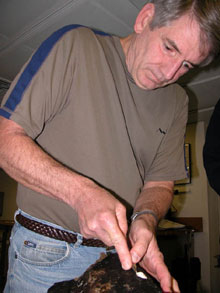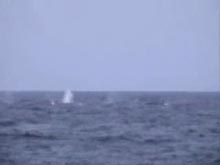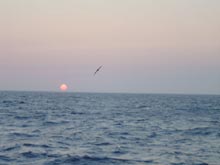The Far Side of the Coral
August 9, 2004
Dr. Thomas C. Shirley
University of Alaska, Fairbanks
Outside of the shipping lanes, the world's oceans are places of solitude. Black-footed albatrosses, sooty shearwaters, and Pacific white-sided dolphins are the only companions for the 55 members of the scientific party and crew aboard the R/V Atlantis.
Today, the scientists on board are are monitoring the movements of the deep submergence vehicle (DSV) Alvin 800 m below on Dickens Seamount. Patiently, they wait for Alvin's return to the surface, scheduled for the afternoon. The submersible will bring with it coral, their invertebrate inhabitants, and rocks (to study the seamount's age and origin). The slow pace of the day's activities will quicken with the arrival of the sub, its treasures, and objects of scientific work.
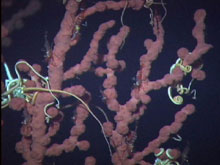
This frame grab shows how many different creatures use deep-sea corals as habitat. This bubble gum coral (Paragorgia sp.) is covered in shrimp. (Heptacarpus sp.) and individuals of a type of brittle star, called basket stars (Asteronyx sp.) Click image for larger view.
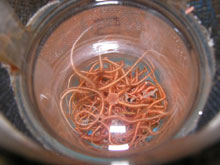
A sample jar from the Alvin full of invertebrates, mostly brittle stars, that were removed from deep-sea corals. Click image for larger view.
We are alone out here, but we are not isolated like scientists of past eras. This is the modern age of electronics and internet communications. I am in communication with scientists more than 1,000 km to the west aboard the R/V Revelle, who are using the remotely operated vehicle (ROV) Jason II to study deep-sea corals along the Aleutian Islands and the Adak Trench. (See photos and essays of their research at www.alaskascienceoutreach.com ![]() .)
.)
I am also communicating with my two graduate students, who are aboard a research vessel in the Gulf of Mexico, more than 6,000 km to the southeast. Those students are using the ROV Triton XL SonSub to study fishes, corals, and invertebrate assemblages on eight WWII shipwrecks in depths from 400-6,000 ft.
In addition to being objects of an archeological investigation by C & C Technologies, the shipwrecks are surrogates for deep-water artificial reefs of known age. The abundance, growth, and diversity of marine life on the shipwrecks will add to our knowledge of growth and colonization rates and provide information to agencies monitoring the establishment offshore drilling platforms. Two Federal agencies -- the Mineral Management Service and NOAA's Office of Ocean Exploration -- are sponsoring this multidisciplinary expedition on board the research vessel HOS Dominator ![]() . Share their adventures on shipwrecks at the Web page www.pastfoundation.org
. Share their adventures on shipwrecks at the Web page www.pastfoundation.org ![]() .
.
The communication links with the outside world are wonderful tools for the exchange of knowledge and for breaking the grip of the solitude of the seas.
Seamounts as Hotspots:
Areas of Diversity and Abundance
Dr. Thomas C. Shirley
University of Alaska, Fairbanks
As we continue our exploration of deep-sea corals and seamount geology in the Gulf of Alaska using the DSV Alvin, we are beginning to recognize an increased abundance and diversity of life at the sea surface above seamounts. A variety of whales, including finback, humpback, and sperm whales, accompany us daily. Dall porpoises often play in the ship’s bow wake or follow the Alvin to the surface.
On Dickens Seamount, Dall porpoises curiously investigated the Alvin as we returned from a dive. The inquisitive marine mammals also investigate any scientific gear we place over the side. This morning, above Welker Seamount, finback whales came within 200 m of the Atlantis! We could clearly see the characteristic grayish blaze pattern along their bodies.
Black-legged albatrosses are also common; eight escorted the boat for several days at Denson Seamount and would soar above the Alvin during the morning launch. Other common birds include sooty shearwaters, storm petrels, plovers, and gulls. The storm petrels often become blinded by lights during our night operations and crash into the ship; all have survived in our "bird hospital" for release the next morning.
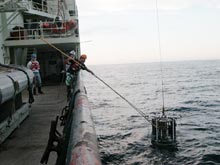
The CTD (conductivity, temperature, and depth) rosette is brought back on deck after having taken water samples and a profile of the water column. Click image for larger view.
While the vessel is stationary at night -- conducting CTD (conductivity, temperature and depth) casts above the seamounts -- the lights from the vessel attract a variety of forage fishes, such as herring and sand lance. Like clockwork, large squid (exceeding two ft in body length) begin jetting about in the surface waters, often in impressive schools. On both Welker and Dickens seamounts, salmon sharks have followed the CTD rosette to the surface, scattering the schooling squid in all directions.
The marine mammals, birds, fish, and invertebrates are more common above seamounts for a reason: food. Phytoplankton production is higher above seamounts because of increased nutrient supply by currents. The phytoplankton—and the zooplankton feeding on them—are retained in the seamount vicinity by Taylor columns, which are eddies created by the submarine structures. The plankton provide the base of a multi-layered food web, the high productivity of which is much less common and less productive at areas away from seamounts.
Data from satellite tracking of radio transmitter-tagged animals are providing increasing evidence that seamounts serve as feeding stations for both pelagic residents and migratory marine species. The increased diversity and abundance of marine life above seamounts certainly affirms the use of the word "hotspot" in describing them.
Sign up for the Ocean Explorer E-mail Update List.

























